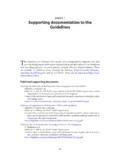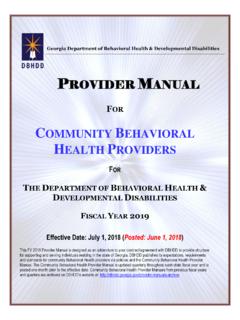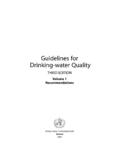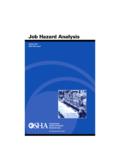Transcription of Medical Necessity & Charting Guidelines
1 Medical Necessity &. Charting Guidelines 1. In most cases we are told the rules up front - or will be told if we ask Like most games, the one who knows the rules the best WINS. 4. 2. Nationally Recognized Industry Guidelines for determination of Medical Necessity used by payor sources: Milliman . InterQual . Payors will approve day/s for patient stay based on these Guidelines . Hospital and physicians have signed contract to use these Guidelines 3. InterQual Guidelines for Medical Necessity Utilized for Medicare patient Acute Care inpatient or Observation Severity of Illness (SI). Intensity of Service (IS). Used for Adult and Pediatric Services Offers Discharge Screens Criteria are specific for Body Systems: Neuro, Cardiac, etc.
2 Care Units: ICU, Intermediate, Medical , Monitored bed 5. InterQual Guidelines for Medical Necessity Criteria for Alternative Level Of Care (ALOC). Long Term acute Care Rehab SNF: Skilled Nursing facility Hospice: Not limited to cancer patient Home Health Reference copy in Library 6. Severity of Illness (SI). What brought the patient to the hospital? Does the patient's condition require stay in ACUTE CARE. settings? WHY? Has the patient FAILED. outpatient treatment? 7. Intensity of Service (IS). What are we doing for the patient that requires an ACUTE CARE setting? Can treatment safely be performed in an Alternate Level Of Care (ALOC)? 8. Discharge Screens Examples of Next Level of Care Pain Controlled with PO Meds Heart Rate 50-100.
3 PO Fluids Tolerated Temperature Resolving Anemia Resolving Wounds Healing 9. InterQual - Alternate Level Of Care (ALOC). Long Term Acute care (Kindred). Acute Rehabilitation (Siskin, HEALTHSOUTH). Subacute Rehabilitation (Siskin). Skilled Nursing Facilities (SNF). Intermediate Care Facilities (ICF) . Nursing Home Home Health Care (HHC). Outpatient 10. ALOC Determination Determine, with the assistance of the Case Manager, the Level of Care required based upon Stability of Patient Proposed Services Safety Issues Family Support 11. documentation . It is very important document and communicate with other care givers about what you are planning to do, reasons for admission to acute care as inpatient or as an observation, treatment plan (plan of care), reasons for continued stay and discharge plan.
4 Review examples shown in next few slides 12. Charting Medical Necessity Patient Status (Admit, Obs, Outpatient). Time and Date (both required). Legible Orders (reduce errors and interruptions). Legible Signature Pager Number Severity of Illness (SI) - Condition, H&P. Intensity of Service (IS) Orders Note Intent to admit should be documented with appropriate Medical Necessity 13. Charting Guidelines If a patient is to be placed in an inpatient status write Admit to inpatient . If a patient is to be in observation status write Place (or hold) in observation avoid writing Admit to 23 hour observation. Follow up in timely manner to determine the patient's progress and continued stay need to admit or discharge the patient.
5 14. Charting Guidelines When Charting concerning the patient's condition, chart patient improving . not patient stable . Stable denotes that the patient is in good enough condition to be discharged and the hospital day will be disallowed due to lack of severity of illness . Write why the patient has to remain in the hospital--what acute care services are being provided or the severity of the patient's condition. 15. Charting Guidelines Avoid Charting awaiting IMCU bed transfer . Rather, chart patient to IMCU soon . The first entry will qualify as a non-acute ICU bed day. Avoid Charting patient doing well, will discharge in This denotes that the patient no longer meets severity of illness criteria to warrant his/her stay in an acute care facility.
6 16. Charting Guidelines Avoidcharting will observe, and discharge in 1 or 2 days . Again, this denotes lack of severity of illness and intensity of service.. 17. Do Chart . Why the patient remains in the hospital in terms of Severity of Illness (SI) and Intensity of Service (IS): What is his/her condition that can only be treated in an acute care facility? What treatment is being provided that can only be performed in an acute care facility? 18. Do Chart . Co-morbidities, complications, and contributing factors (CC's). Patient's History and Physical (H&P). Treatment received prior to being placed in a bed MD Office, ED, other treatment facility 19. Charting Guidelines Do chart in the admit note the initial hospital treatment plan.
7 Discharge summary should include all diagnosis, co- morbidity's and hospital course. Be very specific, , identify the type of pneumonia, location, and organism. 20. Charting Guidelines IM and PO medications without documentation of strong severity of illness does not meet criteria for continued stay. A patient admitted on Friday or Saturday must meet severity of illness and intensity of service and have supporting documentation for the entire weekend to be determined medically necessary. If the patient is stable and outpatient treatment is appropriate then evaluate patient for outpatient procedure and consider discharging the patient. 21. Timely Follow Up If you are part of the admitting team and write OK to discharge if OK with surgery, then follow-up later in the day for the discharge order.
8 If a patient is almost ready to be discharged except for his diet tolerance then you may write the order May be discharged if eating OK. Follow up and write the discharge order. 22. Charting Guidelines Attending physicians must write a progress note daily on a patient's chart -- not just co-sign a resident's note. Please note that the these are suggestions based on InterQual criteria and Milliman criteria used by Medicare, TennCare and most of the major payers. If you have any questions, you may contact Resource Management staff at 2520 for Erlanger or call 6296 for questions at TCTCH. 23.




